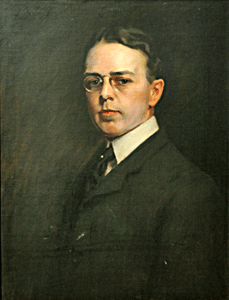| Join | Official Historian, City of Stamford | Blog | About Us | |
| Jewish Historical Society | Civil War Roundtable | Contact Us | |
|
|
|
|
The Stamford Historical Society PresentsBest Face Forward
|
 |
Oil on canvas Irving Ramsey Wiles (1861–1948) Y17-1 Gift of Yale and Towne Manufacturing Co. |
One of three sons of Henry R. Towne, founder of Yale and Towne Manufacturing Co., young Frederick joined the company following his graduation from the Massachusetts Institute of Technology. This forward-thinking young man implemented many of the progressive policies of industrial paternalism introduced at Yale and Towne.
He became superintendent of the company and was very active in professional and civic organizations. He became president of the National Founders Association, as well as the Stamford Manufacturers Association. He also belonged to the Engineers Club of New York and the Stamford Suburban Club.
Sadly, this promising industrialist died at the early age of 32 of a sudden illness following a presentation at an awards program for Yale and Towne employees. This was a great loss for Yale and Towne as well as Stamford.
Irving Ramsey Wiles was born in Utica, New York and educated at the Sedgwick Institute in Great Barrington, Massachusetts. He learned the basics of painting at an early age from his artist father, Lemuel Maynard Wiles who was primarily a landscape painter.
From 1879 to 1881 young Wiles studied at the Art Students League of New York under the guidance of William Merritt Chase, who became his mentor and lifelong friend. Wiles then went to Paris where he continued his training in drawing and further pursued his training in the atelier of Carolus-Duran, who was well-known as a teacher of John Singer Sargent.
Upon returning to New York in 1884 Wiles began to exhibit at the National Academy of Design where he became a full member in 1897. He was considered one of the most highly respected conservative artists between 1880 and 1940.
In the early 1890s Wiles was painting portraits of socially prominent women and their children in the grand manner widely promulgated by Sargent. From this period up to his retirement in the late 1920s he received portrait commissions from all over the United States. His landscapes and interior genre paintings were also highly regarded, but he is best known for his portraits.
Image © Stamford Historical Society